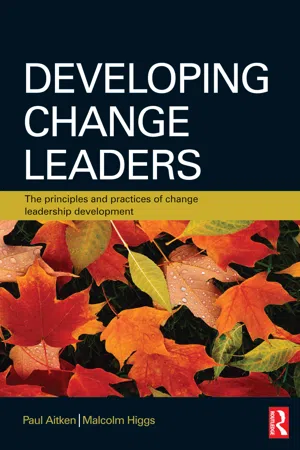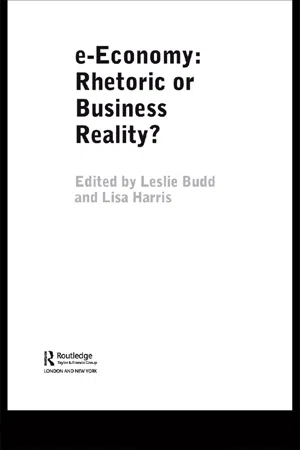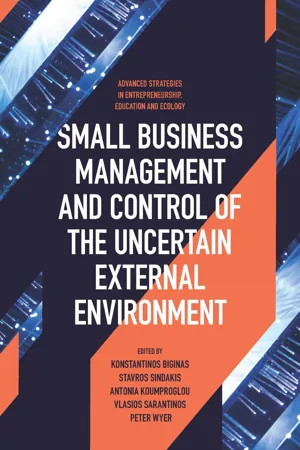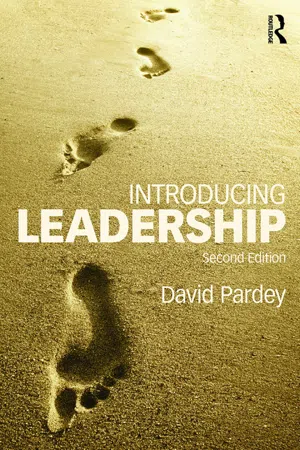Business
Leadership Challenges
Leadership challenges in business encompass obstacles that leaders face in guiding and managing their teams effectively. These challenges may include fostering innovation, navigating change, building and maintaining trust, and fostering a positive organizational culture. Overcoming these challenges requires strong communication, adaptability, and the ability to inspire and motivate others towards a common goal.
Written by Perlego with AI-assistance
Related key terms
Related key terms
1 of 4
Related key terms
1 of 3
6 Key excerpts on "Leadership Challenges"
- eBook - ePub
- Hartley, Jean, Benington, John(Authors)
- 2015(Publication Date)
- Policy Press(Publisher)
CHAPTER 5The challenges of leadership
In this chapter:
We examine the challenges, or purposes, of leadership. What is it that leadership is trying to achieve?First, we examine the challenge of ‘sense-making’ – how do leaders make sense of the context and the purposes they are trying to achieve, and how do they communicate this to others to create a clear sense of common purpose? We examine ‘big picture sense-making’ and then turn to consider the different types of problems that leaders may face, and the degree of match between their leadership strategies and the problem, or challenge, to be addressed. How do leaders think about and orchestrate the work to be done? We distinguish between technical and adaptive challenges (sometimes called tame and wicked problems) and the leadership approaches that seem to be most effective in tackling each of these two types of problem.We then turn to examine five concrete Leadership Challenges for healthcare organisations. These are: the merger/acquisition challenge; leading partnerships and networks; leading organisational turnaround; leading organisational change, innovation and improvement; and nurturing future leaders in the organisation.This chapter focuses on the challenges and purposes of leadership (see Figure 5.1). What are the goals or outcomes that leadership is aiming to achieve? We have called these tasks ‘challenges’ in line with an emerging literature that frames leadership purposes in this way (Heifetz, 1994; Heifetz and Laurie, 1997; Burgoyne et al, 2005; Morrell and Hartley, 2006). Most definitions of leadership focus on purpose in some way – for example, leadership as being influence towards a common goal, or mobilising others to tackle tough problems. The definitions of leadership from Stogdill (1974) or Smircich and Morgan (1982) are a reminder that the leader’s role may also be to find or frame the purpose not just to implement agreed goals, or communicate a vision to others. - eBook - ePub
Relational Leadership
Theory, Practice and Development
- Nicholas Clarke(Author)
- 2018(Publication Date)
- Routledge(Publisher)
Many now share the view that ‘leadership’ is in crisis, unless significant changes are adopted by organisations. This crisis can be summarised in terms of three considerable challenges that a new model of leadership now needs to address. These are the challenges of: (1) leadership capacity; (2) leadership context; and (3) leadership responsibility. (1) The challenge of leadership capacity One of the central ideas in relational leadership – that leadership is a fluid capacity which emerges in response to the particular challenges that arise – was highlighted above as a means to capitalise on collective knowledge and skills in the organisation. Leadership is seen as too important for dealing with the complex challenges facing organisations, to see this as a set of tasks that only managers or those in formal leader positions can be expected to deal with successfully. This is put forward as a major advantage of relational leadership. But the importance of this is not just based on arguments relating to the limits of any one individual’s understanding or cognitive capacities for navigating a way through complex business environments. Neither is it based on egalitarian notions that challenge authority or power structures in organisations, traced to Marxist ideas of capital and class. There is instead a more prosaic reality, namely that major demographic changes within Western economies in particular, will see most organisations facing a significant shortage of skilled employees to fill positions, including those at managerial level typically undertaking leadership roles. In the United States, for example, an estimated 77 million baby boomers will leave the labour market and head for retirement this decade. This will create a major recruitment crisis for business with its impact also on management and leadership positions (IMD, 2008; Su, 2007) - eBook - ePub
- Paul Aitken, Malcolm Higgs(Authors)
- 2010(Publication Date)
- Routledge(Publisher)
Chapter 5 ).Whilst it is important that leadership is understood within a macro-context, it is also necessary to consider leadership within the more specific micro-organizational context. In reality, there is a dynamic between leadership and the organizational context (both macro and micro). There is certainly evidence that the nature of an organization, its purpose, strategies and plans play a part in determining the type of leadership which is considered necessary, the type of people who are placed in leadership roles and the types of actions and behaviors which are recognized and rewarded. There is also good evidence to show that leaders can impact significantly on the nature of an organization and its strategic direction. This dynamic is shown schematically in Figure 1.3 . In reflecting on the dynamic, it is evident that there is an organizational equivalent of the leadership balance shown in Figure 1.2 .The organizational equivalent of the leader’s cognitive abilities (Thinking) may be represented by the organization’s strategy. This represents the organization’s thought through response to its environment and the intent in terms of achieving its core purpose in the face of an evaluation of the environmental challenges and opportunities. The organizational equivalent of the leader’s personality (Being) may be seen as being the overall culture of the organization. Indeed in the vast literature associated with the concept of organizational culture, culture is referred to as the ‘personality of the organisation’. We will explore the nature and significance of culture in a little more detail in the next section. Finally, the organizational equivalent of the leader’s behaviors (Doing) may be seen as being the framework of policies and practices deployed throughout the organization. Combining the leader, and organizational processes creates the opportunity for organizational learning and development, in effect becoming the organizational development agenda, driven by appropriate leadership development. As can be seen from Figure 1.3 - eBook - ePub
e-Economy
Rhetoric or Business Reality?
- Leslie Budd, Lisa Harris(Authors)
- 2004(Publication Date)
- Routledge(Publisher)
From a tradition of ‘I’ve got to stay in control’ to the point that leaders have the courage to set aside hierarchy and exercise self-criticism is a long journey to expect them to take. Owen (2000) suggests that one’s behaviour manifests at the face of ‘persona’ and ‘character’, the former representing the mask behind which one’s self seeks protection against personal fears and anxieties created by the external world, and the latter being one’s real self that goes beyond what we do. Leaders have to know when they act in persona or in character; to maintain the balance between the two they have to go through the ‘layers’ and reveal the deepest personal self rather than try to reinvent themselves in processes or structures which keep them far away from integrity and self-actualization. As such, leaders need to find the courage, for example, to utter phrases like ‘I don’t know’ or ‘you know better than I do’ as a way out of a natural competition process in which they are expected to know everything and do things better than anyone else (Dotlich and Cairo 2002).In summary, leaders cannot easily avoid the strategic dilemmas presented by e-Business opportunities or delegate the issues thus raised to others. Strategic leadershipis multi-functional and involves effective exploitation of core competencies and human resources. This challenges many old myths underpinning traditional leadership paradigms.Case study: LEADERSHIP IN THE BUDGET AIRLINE INDUSTRY
The practical reality of effective leadership in the e-Business context will now be examined in a case study from the airline industry. Such professional service organizations rely heavily upon their human assets; as such they can be characterized as knowledge-intensive organizations. The name of the company has been disguised for reasons of confidentiality, so for the purposes of this case study we will call it Plane Co.Plane Co is an adaptive organization in the sense that it has developed in a very fastchanging market where speed and flexibility are necessary for survival. In 2003 the organization was serving about 10 million passengers per year but its growth rate was very high. - Konstantinos Biginas, Stavros Sindakis, Antonia Koumproglou, Vlasios Sarantinos, Peter Wyer, Konstantinos Biginas, Stavros Sindakis, Antonia Koumproglou, Vlasios Sarantinos, Peter Wyer, Konstantinos Biginas, Stavros Sindakis, Antonia Koumproglou, Vlasios Sarantinos, Peter Wyer(Authors)
- 2022(Publication Date)
- Emerald Publishing Limited(Publisher)
Chapter 6
Leadership: Its Role Within Small and Medium-sized Enterprises
Gratien J. J. David PillaiChapter Contribution
In this chapter, we will be exploring the role of leadership within small businesses. Leadership is an essential element in the management of any organisation and is even more crucial when it comes to small businesses. In particular, both the structure and the specific stage of development of small businesses determines the need for an evolving style of leadership. Unlike their counterparts at larger organisations, small business leaders usually have a higher level of hands-on involvement across multiple areas of responsibility, including strategic decision-making and financial management, as well as team leadership and motivation.Some key leadership skills, such as having a clear vision, communicating successfully across all business levels, leading by example and keeping the team engaged, are shared by all enterprises, regardless of size and nature. It is critical for small business leaders to understand that each stage of an organisation’s lifecycle brings with it different opportunities and challenges that should be dealt with by adopting different leadership techniques. A ‘one-size-fits-all’ approach will not work, and could even become detrimental in the long term.During an organisation’s early days, a leader’s main role is to inspire the individuals they work with by sharing their vision and purpose without the need for formal management processes. In this chapter, we will be exploring the above issues in relation to the role of leadership within small businesses in greater depth.Introduction
Leaders in today’s changing world play a critical role in shaping the future of every type of organisation. One of the objectives for every organisation is to be innovative and creative as this will improve its performance and enable it to survive through tough and challenging times. Organisations are under increased pressure from competitors, economic crisis, global pandemics and regulations. They are constantly pressurised to improve their performance in order to survive in today’s changing world (Arslan & Staub, 2013 ). Small business, as a subject, is creating a lot of interest among practitioners, academics and politicians (Arham, 2014 ). Various studies have pointed out that leaders play a critical role in enabling organisations to improve their performance (Boal & Hooijberg, 2001 ; Choudhary, Akhtar, & Zaheer, 2013 ). Evidence from previous studies has pointed towards how leaders have played an important role in improving the performance of small businesses through their leadership (Avolio & Yammarino, 2013 ; Spinelli, 2006 ). Leaders have been able to influence, inspire and motivate the employees to perform at a higher level in order to improve the performance of the SMEs (Tucker & Russell, 2004- eBook - ePub
- David Pardey(Author)
- 2016(Publication Date)
- Routledge(Publisher)
1 The new leadership challengeThere is a lot of discussion about leadership and its importance in determining organisational performance, but it’s not necessarily a new discussion; in the past there have been similar discussions about the need for better management. This shift, from emphasising the importance of management to emphasising the importance of leadership, may reflect a change in the nature of the problem, and its consequent solution, but it is just as likely to be a change in the language.As we will see, there is often confusion about what is meant by the terms ‘leadership’ and ‘management’ and this confusion doesn’t help us understand how to become a better leader (or manager, for that matter). In this first chapter, we will explore where this challenge, the challenge of being a better leader, is coming from, and use this to start our exploration of what leadership is, an exploration that continues into Chapter 2 .The journey from administration to leadership
A few years ago I had a conversation with Richard Boyatzis (see box 1.1 ), who has dedicated his research career over more than 30 years to exploring what makes people successful as leaders and managers. He argued that US organisations became concerned about their ability to compete internationally during the early part of the twentieth century, and encouraged the growth of university business schools, teaching business administration (hence the MBA – the Masters in Business Administration).Box 1.1: Richard BoyatzisRichard Boyatzis is Professor in the Departments of Organizational Behavior, Psychology, and Cognitive Science at Case Western Reserve University. In recent years he has become one of the world’s leading academic authorities on emotional intelligence (something dealt with in Chapter 5 ), but underlying this interest is his valuable contribution to our understanding of the set of behaviours that define effectiveness in leadership and management – or competence
Index pages curate the most relevant extracts from our library of academic textbooks. They’ve been created using an in-house natural language model (NLM), each adding context and meaning to key research topics.
Explore more topic indexes
Explore more topic indexes
1 of 6
Explore more topic indexes
1 of 4





